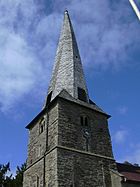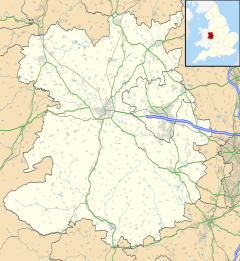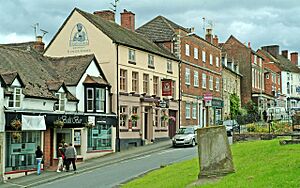Cleobury Mortimer facts for kids
Quick facts for kids Cleobury Mortimer |
|
|---|---|
 High Street and the Talbot Hotel |
|
| Population | 3,036 (2011) |
| OS grid reference | SO675758 |
| Civil parish |
|
| Unitary authority |
|
| Ceremonial county | |
| Region | |
| Country | England |
| Sovereign state | United Kingdom |
| Post town | KIDDERMINSTER |
| Postcode district | DY14 |
| Dialling code | 01299 |
| Police | West Mercia |
| Fire | Shropshire |
| Ambulance | West Midlands |
| EU Parliament | West Midlands |
| UK Parliament |
|
Cleobury Mortimer is a small market town in south-east Shropshire, England. In 2011, about 3,036 people lived there. King Henry III gave the town permission to hold a market in 1226. This made it an important local trading spot.
Contents
History of Cleobury Mortimer
What's in a Name?
The town's name comes from old English words. Clifu meant a steep place, and bury meant a strong, fortified settlement. The "Mortimer" part comes from Ranulph de Mortimer. He was a Norman lord who received this land after the Norman conquest of England in 1066. His family, the Mortimers, became powerful lords in the Welsh Marches (the borderlands between England and Wales) for many years.
Early Days and Castles
Cleobury Mortimer is even mentioned in the Domesday Book. This was a big survey of England made in 1086. There were at least two castles nearby. Cleobury Castle was close to St Mary's Church. It was destroyed in 1155, and only earth mounds are left today. Toot Castle was on the other side of the River Rea.
The town centre was planned with special plots of land called burgage plots. You can still see where these plots were today. As the border with Wales became more peaceful, Cleobury's importance as a military stronghold faded. It became a quiet market town.
Iron and Industry
In the 1500s, people started using the iron found in the area. When Queen Elizabeth I gave the town to Robert Dudley, Earl of Leicester, he helped set up an important iron industry. There were furnaces to make pig iron and forges to turn it into wrought iron. For a while, Cleobury's iron was very important in Shropshire. Shropshire is sometimes called the birthplace of the Industrial Revolution.
However, it was hard to transport goods in and out of Cleobury. This led to the iron industry declining in the early 1800s. The town went back to being mostly about farming. A large paper mill on the River Rea also closed after a big fire.
By 1900, Cleobury was a busy local centre. It had a railway station, a workhouse, a court, a police station, and schools. Over time, many of these local services have closed. This is a common story for many small towns as transport improved and services became more centralised.
Famous Writers from Cleobury
Two famous writers have strong links to Cleobury Mortimer.
William Langland
William Langland lived in the 1300s, around the same time as Geoffrey Chaucer. Many believe he was born near Cleobury. He is remembered in the beautiful East Window of St Mary's Church. A local road is also named after him.
Simon Evans
Simon Evans was a writer in the 1900s. He fought in the First World War and was affected by poison gas. After the war, he became a postman in Cleobury. The quiet country life helped him recover. He took a writing course and became a successful writer and radio broadcaster in the 1930s. He wrote five books. Sadly, he passed away in 1940 due to the effects of the gas.
You can still see his legacy in Cleobury. A street is named after him, and there's a plaque on the old Post Office. There's also a walking trail called 'The Simon Evans Way'.
Geography of Cleobury Mortimer
Rivers and Hills
The River Rea flows to the east of Cleobury Mortimer. A smaller stream called Pudding Brook (or Burrell Brook) runs through the town. The land in Cleobury rises from about 110 metres near the river to 150 metres in the west. The Clee Hills, which are the highest hills in Shropshire, are very close by. The Wyre Forest is also nearby, between Cleobury and Bewdley. The border with Worcestershire is only about a mile to the south.
Roads and Transport
The A4117 road, which connects Kidderminster to Ludlow, goes right through the town centre. It crosses the River Rea at New Bridge. The B4363 road connects Cleobury Mortimer to Bridgnorth. Cleobury is about 33 miles from Shrewsbury, the county town. This makes it the furthest town from Shrewsbury in Shropshire.
Cleobury used to have two railway lines, but they are now closed. The Tenbury & Bewdley Railway and the Cleobury Mortimer and Ditton Priors Light Railway both served the area. Today, the closest railway stations are on the heritage Severn Valley Railway. For mainline trains, you can go to Ludlow or Kidderminster. There is a regular bus service (Diamond Bus 292) that runs between Ludlow and Kidderminster, passing through Cleobury.
Local Area and Nearby Villages
The area around Cleobury Mortimer town is called the civil parish. It's mostly rural and includes part of the Wyre Forest. In 2017, the local council changed its name to Cleobury Mortimer Town Council.
To the north of Cleobury are the villages of Neenton and Neen Savage. To the south-west is the small village of Neen Sollars. The word "Neen" was the old name for the River Rea. Further north is Cleobury North, another small village with a similar name origin.
 |
Clee Hills Hopton Wafers |
Stottesdon Neen Savage |
Kinlet, Highley |  |
| Ludlow, Clee Hill Village | Wyre Forest, Bewdley Kidderminster |
|||
| Milson Tenbury Wells |
Neen Sollars, Mamble | Bayton |
Local Government
Cleobury Mortimer is part of an electoral ward (a voting area) of the same name. This ward mostly stretches to the north of the town. In 2011, this ward had a population of 7,226 people.
Landmarks and Things to Do
St Mary's Church

One of the most famous landmarks in Cleobury is the 12th-century St Mary's Church. It's in the town centre and is famous for its crooked spire. The spire looks bent because its old oak timbers have warped over time. Also, dampness where the timber spire meets the stone tower has caused some rot.
Other Places of Interest
Across the road from the churchyard is The Wells. This is a spring that has provided public water for centuries. In 2010, the water flow stopped for a while and has only been on and off since then. To the west of the church is the Market Hall. It has been recently updated and now includes the Tourist Information Centre.
Cleobury has six public houses (pubs) in the town. There's also another one, the Blount Arms, on the road towards Kidderminster. The town has a secondary school called Lacon Childe, a primary school, a library, a post office, and a fire station. It used to have a police station until 2014.
In 2006, the town was featured in a series of reports on BBC Breakfast by Declan Curry. He interviewed local people and business owners to learn about the rural economy.
Hobsons Brewery
Hobsons brewery started in 1993. It moved to its current location just outside the town centre in 1995. The brewery makes and delivers its beer to pubs within 50 miles. They also sell special bottled beers to shops across the UK. Their mild, best bitter, and strong bitter (Old Henry) have won awards for their taste. In 2008, their mild beer was even served in the House of Commons bar!
Hobsons also makes a bottled mild ale called Postman's Knock, named after the writer Simon Evans. In 2009, the brewery put in a small wind turbine. This turbine creates about a third of the electricity the brewery needs. The company also uses other environmentally friendly technologies. The King's Arms pub in town became the brewery's main pub in 2007. It was also the first pub to receive Hobsons beer back in 1993. Hobsons also makes two special beers for the local heritage railway, the Severn Valley Railway.
Media and News
You can get local news and TV shows from BBC West Midlands and ITV Central. TV signals come from either the Sutton Coldfield or The Wrekin TV transmitters.
Local radio stations include BBC Radio Shropshire, Heart West Midlands, Smooth West Midlands, Hits Radio Black Country & Shropshire, Sunshine Radio, and Greatest Hits Radio Black Country & Shropshire.
The local newspaper that serves the town is the Shropshire Star.
Notable People from Cleobury Mortimer
- Hugh de Mortimer (born before 1117–1180/81), a Norman English baron and local lord.
- Oliver Mathews (around 1520 – around 1618), a Welsh pharmacist and historian who owned land in Cleobury Mortimer for a time.
- William Hayley (1683–1715), a Church of England priest who was a dean of Chichester Cathedral.
- Edward Northey (1755–1828), a Vicar of Cleobury Mortimer and a Canon of Windsor.
- Thomas Botfield (1762–1843), an English expert in metals and geology who went to school in Cleobury Mortimer.
- Simon Evans (1895–1940), a postman, writer, and radio broadcaster known for his stories about country life.
- Richard Jones (1916 – 2004 in Cleobury Mortimer), an English cricketer who played for Warwickshire.
- John David Brewer (born 1951), an English sociologist, professor, and author who grew up in Cleobury Mortimer.
- Chris Rokos (born 1970), a leading hedge fund manager who lives partly in Cleobury Mortimer.
Images for kids
See also
 In Spanish: Cleobury Mortimer para niños
In Spanish: Cleobury Mortimer para niños





